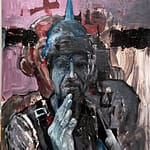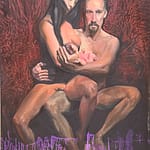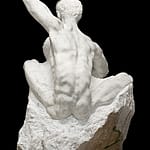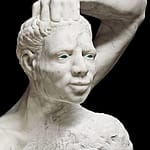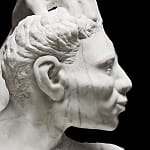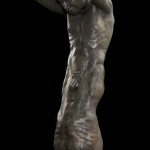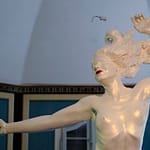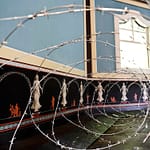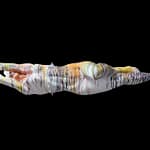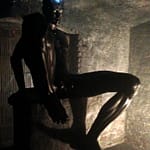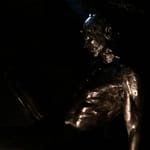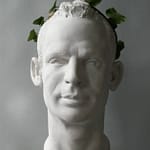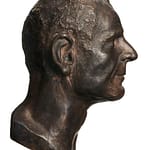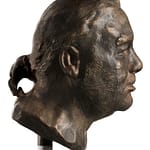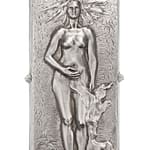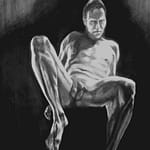Early Works – From Abstraction to Figuration
Coming from a strongly „bauhaus“ influence, the artist started with abstract yet organic forms. It took a while, being brave enough re-creating figuration and daring to work with the human body. CHESTNUT is an example of those early works (before 1988) when-after 1990 the quest of figuration started.
Exploring Conditions of the Human Soul
After creating numerous smaller attempts of figurative works in wood and in clay the artist staged two live size figures in 1990 (CRUCIFIED, oak wood) and 1991 (AROUSED, Carrara marble). Both sculptures fit into the Monomyth Cycle, yet not established then. The marble, begun in the artist’s twenties, was finished after 17 years in 2008.
EXPLORING CONDITIONS OF THE HUMAN SOUL II – The monomyth cycle
Starting from basic human actions that became traditions over the centuries of sculpting since Egypt and Greek Antique, the standing figure, the walking figure and the lying figure, the artist further explored conditions of being human in our world throughout the nineties. After several years, Krumrey realized, he was telling a mythological pattern, known as the Hero’s Journey or Monomyth. Its a storyline which is repeated endlessly in countless ages, cultures and languages, as American mythologist and writer Joseph Campbell discovered, just over 50 years ago. Campbell found that myths from every culture he evaluated shared a common theme – a circular narrative pattern of danger and redemption. The hero is forced to leave the safety of home, crossing a threshold beyond which lies adventure. He is exposed to great danger and has to face a series of tests, after which he receives divine help, discovers his true heritage and returns home to enrich the society he has left with his new-found knowledge. The pattern, first named by James Joyce, became very popular in storytelling especially in the film industry.
When Krumrey realized in 2006, he was following in his search of cardinal soul conditions of human subsistence the very same pattern, without even knowing it, he started using it as a compass and guideline for his future work.
The first cycle of works, begun in 1996, explored the basic human actions and combined it with a dialogue of the Torso (truncation, shown in HELPLESS, CALM, NIKE, MAN-WO-MAN versus „non finito“ as realized in AROUSED) and a simultaneous dialogue of abstraction versus figuration (CALM, HELPLESS, AROUSED, PRESSURE DROP, BROTHERS)
The opposite of truncation – combination – resulted into several artworks of combining artificial bodies of antagonistic entities, as seen in BROTHERS (1997 / 2010), PRESSURE DROP (1997), MAN-WO-MAN (2006 / 2012).
The understanding of built space (architecture) and sculpture as two antagonistic poles, meaning that architecture creates negative spaces (interiors) whereas the positive volume of sculpture dispenses space – the artist begun in 2010 with the development of built environments or architectural stages. Krumrey intentionally controls all senses of the visitor by defining acoustics, light, temperature, smell, sensorial and body impression in order to create a holistic artwork (Gesamtkunstwerk).
Examples could be seen 2010 at Brienner 48, Munich and at the International Art Festival of Arenas de San Pedro near Madrid, Spain.
BREATH – Brienner 48
http://vimeo.com/12610376
BREATH – Arenas de San Pedro
http://vimeo.com/20182055
And differently – as an environment in an existing setting – RESURRECTION at Hexenhaus, in Bavaria, 2011, at Nymphenburg Castle, Munich.
As another work of the „combination“ theme could be considered IKARUS (2008 / 2011), where Krumrey created a Metamorphosis in melting animal forms (lion, eagle) with human. Additionally he integrated pigments and colored surface into his sculpture in order to extend the range of visual impression.
The third formal theme started in 2008. After „truncation“ and „combination“ Krumrey started to work with „shifting“ the human figure. Very well based on the tradition of standing or lying figures, all following the physical static of body and gravity, the artist started to explore the shift in perception when shifting the gravitational direction of the human body in his statues.
He first begun with a lying female figure in 2008, for the first time in his figurative artwork since 1990 complete and entire in all extremities, in order to purely focus on the new theme of „shifting gravity“. 2011 DORNRÖSCHEN I was finished and first time presented in the Nymphenburg Castle environment. The figure was formed lying on her back and presented in a 90 degree upward shift, creating a strange floating impression.
RESURRECTION at Hexenhaus, environment Nymphenburg Castle, Munich, 2011.
DORNRÖSCHEN II, even though begun earlier (2008), was later finished (2012). The lying figure is 180 degrees rotated on its longitudinal axis and presented at a hight of 1,6 m to 2 m above the floor. The flawless lines and curves of the volumes of the body were distorted at distinctive places on neck and chest by outbreaking pinnacles. The immaculate white of the marble pigment covered body was incarnated with oil colors on chest, neck and face.
As a further step in the Monomyth cycle Krumrey created in 2013 ADAM, a life size bronze of the human ancestor, based on sumerian mythology. It represents the „Nadir“, i.e. the low point, or crisis, metamorphosis of the hero on his journey within the narrative pattern of Monomyth.
On the formal layer, Krumrey started to investigate the method of „blurring“ the surface of his sculpture (the fifth formal theme of his work). The lower part is as precisely smoothened as in antique sculptures whereas the upper part of chest, neck and head of the figure is rough, covered with cuts and injuries that rip the smoothness of the body surface.
The figure was first time presented in a cave of the M45 artspace in Munich in an installation of space, sound, light and scent.
During summer 2016 the artist built the second Gesamtkunstwerk MONOMYTH BLOCK II – THE CIRCLE, combining an unique video artwork together with a sculpture (DORNRÖSCHEN II) and an installation to walk in, while the video was projected on the canvas of the space from the outside. The installation was realized at the Minima LAB of Minima Gallery, Mykonos, Greece.
Documtentation and STORAGE of Civilisation
„100 Menschen 100 Köpfe“, started in 2007, is the attempt of finding truth in closest observation of individuality and humankind by giving the results of this observation in a portray in durable materials, such as bronze, silver or other casting materials with durability periods of several hundred years. The growing number of portrays will be shown from time to time in environments and exhibitions as silent witnesses of the situation. These heads are equally stored electronically, as medium is used a blog in the internet about the making of 100 human heads of living beings of our time. Some results here:
Finding Truth in Grotesque
In the European Renaissance treasury chambers, where pieces of art, archeological artifacts, absurdities, obscenities and curiosities were kept were very popular. The guests of the landlord were meeting there, drinking, joking and discussing the exhibits. The tradition of collecting grotesque artifacts reaches back to the Antique. Antique grotesque heads were sometimes used as plugs for bottles and/or other common household objects as well as in single pieces of art. Grotesques, understood as wake-up call or delusion of being could be found in many periods and all fields of art, as well as in literature, theatre, movie and music. Reviving this idea, the artist started in 2006 a series of (mostly very small) grotesque heads, made out of precious metals and other materials like bronze or plaster.
Archetypal reasons for economic crisis – a piece of concept art
Combining knowledge of money, value and economic structures with mythological archetypes (Krumrey studied economics and worked for some years as financial advisor for investors and entrepreneurs) resulted into a concept artwork, where the physical aspect of the sculpted and formed 5 kg fine silver relief is only one aspect beneath the documentation of market and visualization of economical behavior in an artistic way.
Painting and drawing as parallel universe
2013 the artist began a new branch in his art, life size drawings in order to develop, anticipate and/or mirror sculptural ideas
2020 the paintings evolved into another universe of their own. Still based on various perceptions of human body and other figurative ideas, but including landscape and still-life into the tableau of painting.


